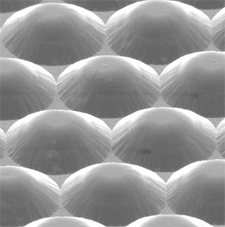08 December 2006
 While white-light OLED shows promising future as lighting source (e.g., see an earlier post), getting enough light out of OLEDs to make them practical remains tricky.
While white-light OLED shows promising future as lighting source (e.g., see an earlier post), getting enough light out of OLEDs to make them practical remains tricky.When electricity runs through the thin layers of organic polymers that make up the OLEDs, it causes the material to emit photons. The problem is that only about half of the photons ever reach the surface of the device, and about three-fifths of those that do reach the polymer/air interface get cattered to the edges of the polymer and never reach an observer's eye.
A research group led by Stephen Forrest, a professor of electrical engineering and vice president of research at the University of Michigan, recently developed a technology that can nearly double the light output of the thin, flexible OLEDs.
In their design, Forrest uses microlenses, tiny hemispheres of polymer a few micrometers in diameter that direct the light, allowing 70 percent more light to emerge from a white-light OLED.
This research has been recently published in Journal of Applied Physics (link available here).
(Via Technology Review)
0 Comments:
All Topics



